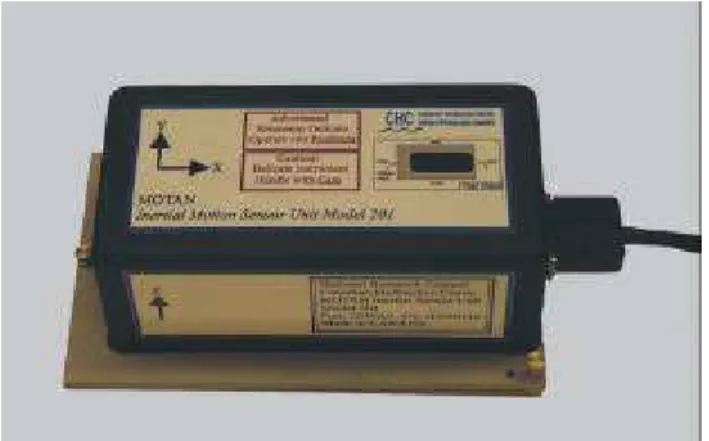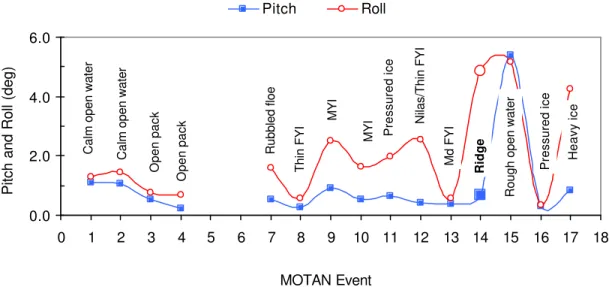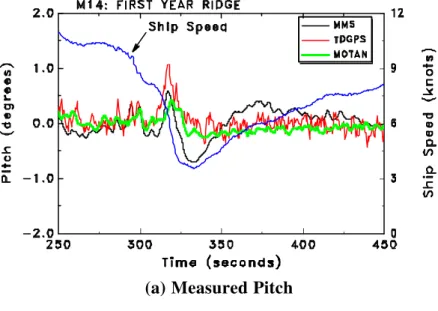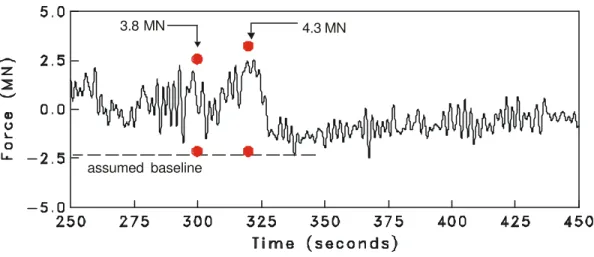Publisher’s version / Version de l'éditeur:
Proceedings 16th International Conference on Port and Ocean Engineering under Arctic Conditions, POAC'01, pp. 955-964, 2001-08-12
READ THESE TERMS AND CONDITIONS CAREFULLY BEFORE USING THIS WEBSITE.
https://nrc-publications.canada.ca/eng/copyright
Vous avez des questions? Nous pouvons vous aider. Pour communiquer directement avec un auteur, consultez la première page de la revue dans laquelle son article a été publié afin de trouver ses coordonnées. Si vous n’arrivez pas à les repérer, communiquez avec nous à PublicationsArchive-ArchivesPublications@nrc-cnrc.gc.ca.
Questions? Contact the NRC Publications Archive team at
PublicationsArchive-ArchivesPublications@nrc-cnrc.gc.ca. If you wish to email the authors directly, please see the first page of the publication for their contact information.
NRC Publications Archive
Archives des publications du CNRC
This publication could be one of several versions: author’s original, accepted manuscript or the publisher’s version. / La version de cette publication peut être l’une des suivantes : la version prépublication de l’auteur, la version acceptée du manuscrit ou la version de l’éditeur.
Access and use of this website and the material on it are subject to the Terms and Conditions set forth at
Whole-ship motions of USCGC Healy as applied to global ice impact forces.
Johnston, Michelle; Timco, Garry; Frederking, Robert; Miles, M.
https://publications-cnrc.canada.ca/fra/droits
L’accès à ce site Web et l’utilisation de son contenu sont assujettis aux conditions présentées dans le site LISEZ CES CONDITIONS ATTENTIVEMENT AVANT D’UTILISER CE SITE WEB.
NRC Publications Record / Notice d'Archives des publications de CNRC: https://nrc-publications.canada.ca/eng/view/object/?id=0c9d520b-ae3c-40ea-ac20-b74dea6cb751 https://publications-cnrc.canada.ca/fra/voir/objet/?id=0c9d520b-ae3c-40ea-ac20-b74dea6cb751
WHOLE-SHIP MOTIONS OF USCGC HEALY AS APPLIED TO GLOBAL ICE IMPACT FORCES
M. Johnston, G. Timco, R. Frederking and M. Miles
Canadian Hydraulics Centre National Research Council Ottawa, Ontario K1A 0R6 Canada
ABSTRACT
Providing the whole-ship motions in ice operations was part of the Canadian contribution to the Arctic Ship Technology Research and Development Program conducted on the USCGC Healy. An inertial measurement system was used to measure the whole-ship motions of the USCGC Healy during its Ice Trials, April/May 2000. The system provided time-series traces of ship motions in six degrees of freedom. A variety of loading conditions was sampled, ranging from relatively light ice conditions to backing and ramming in pressured first- year ice and multi- year ice. The ship motions experienced under the different ice conditions ranged from pitch angles of 0.2° to 0.8° and roll angles of 0.6° to 4.9°. A representative case in which the ship rammed a first-year ridge in open pack ice is discussed. During that event, the ship experienced a 0.7° pitch and 4.9° roll. The whole-ship motions during the ridge impact were used to estimate a vertical bow force of 4.3 MN.
INTRODUCTION
The literature contains very little information about ship response during ice breaking operations (German and Milne Inc., 1985; Fleet Technology Ltd., 1997). To obtain information about the ship response in ice-covered waters, the Canadian Hydraulics Centre used an inertial measurement system, the MOTAN, to measure whole-ship motions. The MOTAN system provides time-series of ship motions in six degrees of freedom. The first, full-scale deployment of the MOTAN was on the USCGC Healy during its Ice Trials, conducted in April and May 2000. Data acquired during that voyage were used to determine the feasibility of using the MOTAN system to measure full- scale, whole-ship motions from which global ice impact forces can be then calculated.
POAC ‘0 1
Ottawa, Canada
Proceedings of the 16 International Conference onth
Port and Ocean Engineering under Arctic Conditions POAC’01 August 12-17, 2001 Ottawa, Ontario, Canada
MOTAN INERTIAL MEASUREMENT SYSTEM
The MOTAN is a two-part package that consists of a physical sensor and a computer program (Figure 1). The MOTAN system was initially developed at the Canadian Hydraulics Centre to measure the motion of model-scale ships and floating structures in a wave basin. Favorable performance of the MOTAN system at the model-scale led to the conception of using it at full-scale to measure the ship response during ice breaking operations.
MOTAN
Rate Acceleration Sensor:
3 accelerometers 3 angular rate sensors
Computer Program: 18 time series traces
Displacement x y z Heave Pitch Roll Yaw Sway Surge Surge x x x Sway y y y Heave z z z Pitch θ θ θ Roll φ φ φ Yaw ψ ψ ψ
Figure 1 Schematic of MOTAN system
MOTAN Sensor
The MOTAN sensor is 260 mm long, 160 mm wide, 100 mm high and weighs 1.88 kg (Figure 2). The sensor is equipped with three accelerometers and three angular rate sensors arranged in a strapdown configuration. The accelerometers measure the total acceleration (including the earth gravity components) along the X, Y and Z body axes of the ship. The rate sensors measure the three-dimensional angular rotational rate of the ship, resolved along the instantaneous positions of the X, Y and Z body axes. A standard data acquisition system is used to record six analog voltage signals from the MOTAN sensor. Since the MOTAN can be installed easily at any convenient location on the vessel it has a great deal of flexibility, making it an ideal unit for field operations.
Figure 2 MOTAN sensor used in measuring whole-ship motions
MOTAN Computer Software
The six analog signals from the MOTAN sensor are processed using computer software developed at the Canadian Hydraulics Centre. The computer program uses appropriate equations of motion (Newman, 1977) to convert the measured ship accelerations and angular rates into whole-ship motions. The program outputs time series of displacement, velocity and acceleration for each of the surge, sway, heave, roll, pitch and yaw motions (Figure 1). The whole-ship motions can be computed at any point, regardless of where the MOTAN sensor is located, provided the positional coordinates of the sensor are known and the ship can be reasonably assumed to be a rigid body.
MOTAN INSTALLATION AND OPERATION ON THE USCGC HEALY
The USCGC Healy Ice Trials were conducted from 2 April to 15 May 2000 between Halifax, Nova Scotia and Nuuk, Greenland. En route to Nuuk, the ship passed through open water, marginal ice and consolidated pack ice (Johnston and Gorman, 2001). The Ice Trials provided an excellent opportunity to record whole-ship motions under a variety of conditions. During the Ice Trials, the MOTAN was used to measure the whole-ship motions for 17 different loading scenarios during the first leg (2 April to 25 April 2000) and the second leg (25 April to 21 May) of the voyage.
The MOTAN sensor was installed on the USCGC Healy while the ship was docked in Halifax. The MOTAN sensor was securely fastened to a bulkhead, the unit was connected to a data acquisition system and baseline readings were taken. The data acquisition system used for the MOTAN was also used to sample data from the strain gauge panels installed on the starboard shoulder of the vessel (St. John et al., 2001). Since the MOTAN needed to be close to the data acquisition system, the unit was located 27 m forward of the centre of gravity of the ship (Figure 3). It is preferable to install the MOTAN near the centre of gravity because that is a convenient reference point about which to calculate whole-ship motions and non-rigid body vibrations are minimized at the centre of gravity. The distance of the MOTAN sensor from the centre of gravity changed as the USCGC Healy used fuel and re-distributed
ballast during the voyage. The positional vector of the MOTAN was updated each week, based upon the vessel stability summary provided by the United States Coast Guard.
CHC on bridge STC in aft lab
Motan Centre of Gravity waterline length = 121 m 27 m +16 m +9 m +29 m
Figure 3 Location of the MOTAN unit on the Healy
The MOTAN could either start recording using a manual trigger (prior to loading conditions of interest) or an automatic trigger (when strain gauge data exceeded a preset threshold). When manually triggered, personnel from Canadian Hydraulics Centre would phone STC (Figure 3) and request that MOTAN data be recorded. The data sampling frequency used for the MOTAN ranged from 20 to 50 Hz. Although ship motions are in the low frequency range (around 3 Hz based upon Glen et al., 1982), higher sampling frequencies were necessary to avoid aliasing in the data.
Independent Ship-based Motions Packages on the USCGC Healy
The USCGC Healy was equipped with two onboard, commercial ship motion packages that provided limited information about the heave, pitch and roll of the ship. Those two packages were not meant for scientific evaluation during the Healy Ice Trials. Although not expected initially, several components from the MOTAN were able to be cross-checked by the onboard motion systems.
The first commercial system, referred to as TDGPS, was designed and manufactured by Ashtech. The TDGPS relied upon differential measurements from four ship- mounted antennas to provide digital output on the pitch, roll, heading, position and ship speed. The TDGPS was a proven system that has been shown to be very accurate (internet communication, Ashtech). The second onboard system was the dynamic motion sensor or MMS (marine motion sensor). The MMS provided digital output of the heave, pitch and roll. That sensor consisted of an orthogonal array of three linear accelerometers and three vibrating gyroscopes.
EVENTS LOGGED WITH THE MOTAN DURING THE ICE TRIALS
Figure 4 shows a summary of the maximum range of pitch and roll motions measured by the MOTAN during the 17 events logged throughout the Ice Trials. A brief descriptor of the associated ice conditions is also given. Thin first- year ice (Event M08) and medium first- year ice (Event M13) resulted in noticeably smaller motions than ridged, rubbled or pressured first-year and multi- first-year ice. In all cases where the USCGC Healy operated in ice, the ship roll exceeded its pitch. That was also the case for the two calm water events (M01 and M02). The most notable pitch and roll occurred in the rough open water conditions of Event M15, where the pitch and roll motions were of similar magnitude (5.4° and 5.2° respectively). The next largest pitch motion was measured during the multi- year impact of Event M09 (0.9°+ pitch and 4.3°+ roll). The short record length for multi- year impact in Event M09 prevented the peak pitch and roll angles from being captured completely.
0.0 2.0 4.0 6.0 0 1 2 3 4 5 6 7 8 9 10 11 12 13 14 15 16 17 18 MOTAN Event
Pitch and Roll (deg)
Pitch Roll
Rough open water
Calm open water Calm open water
Open pack
Open pack
Rubbled floe
Thin FYI
MYI
MYI Pressured ice
Nilas/Thin FYI
Md FYI
Ridge Pressured ice
Heavy ice
Figure 4 MOTAN Measured Pitch and Roll for Reported Intervals
The heavy ice of Event M17 and the ridged ice of Event M14 also resulted in significant ship motions. The pitch and roll during Event M17 were 0.8° and 4.3°. Event M14 had a pitch and roll of respectively 0.7° and 4.9°. During Event M17 data were not available from the ship-based systems. The following discussion focuses therefore upon the ridge impact of Event M14.
The ridge impacted during Event M14 resulted in the highest ship roll motion (4.9°) of any ice feature sampled during the Ice Trials, and also had a significant pitching motion (0.7°). Event M14 was selected to illustrate first, the comparison between the three, ship motion packages. Second, the ship response during Event M14 is used to demonstrate how the MOTAN software estimates the total vertical bow force.
EVENT M14: FIRST-YEAR RIDGE
On 23 April the MOTAN was triggered manually as the USCGC Healy passed through open pack ice en route to Nuuk, Greenland. The ice cover had a 9/10th total ice concentration, most of which consisted of medium first- year ice floes from 50 to 500 m in diameter. Quite unexpectedly, the ship impacted a ridged ice floe while Event M14 was being logged. Observations from the bridge revealed that the ridge impact resulted in significant rolling and pitching motions. Figure 5 shows a comparison of the pitch and roll motions measured by the three, ship motion packages during the ridge impact of Event M14. The ship speed, obtained from the TDGPS system, is superimposed on the pitch and roll time-series.
(a) Measured Pitch
(b) Measured Roll
Note the excellent agreement of ship motions registered by the three independent systems in Figure 5. Since it was not possible to zero the MOTAN in open water or level ice prior to each event, offsets (mean values) were removed from the MOTAN, MMS and TDGPS time series. Consequently, the time-series in Figure 5 are a measure of the relative change in attitude of the vessel during the impact, rather than absolute values.
The ship experienced two notable instances of pitch and roll during the 200 second record shown in Figure 5. First, the bow of the ship rose by 0.4° (at 300 sec) followed by a bow rise of about 0.7° (at 320 sec). The pitching motions were accompanied by a 5.5° change in roll and the ship speed reduced from 11 to 4 kts.
EVENT M14: GLOBAL ICE IMPACT FORCE
Event M14 is used to illustrate how global ice impact forces can be estimated from whole-ship motions. Since the complete characterization of whole-ship- ice interaction is extremely complex, the mechanics of the problem were simplified by assuming that the ship impacts an ice feature head-on and does not experience significant motion in the lateral direction (i.e. sway and roll are assumed negligible). Having made that assumption, ship motions can be reasonably limited to pitch and heave and the global ice impact force can be reduced to a vertical bow force.
The standard equations of motion for coupled heave and pitch motions of a vessel operating in head seas are derived in Comstock (1967). The general coupled heave and pitch equations are shown in Equations (1) and (2).
(1) ( ) 2 ( ) 2 2 2 t F h t d d e t d d d z c t d z d b t d z d a m+ + + + θ + θ + θ = (2) ( ) 2 ( ) 2 2 2 t M z H t d z d E t d z d D C t d d B t d d A Iy + θ + θ + θ + + + = where θ pitch of ship z = heave of ship
m = mass of the ship
Iy = mass moment of inertia of the ship about the midship y-axis
F(t) = total external force
M(t) = total external moment
In principle, either Equation (1) or Equation (2) could be used to estimate the ice impact force acting at a specified position along the hull of the ship. Equation (2) was selected because it is based upon the total pitching moment acting on the hull. The MOTAN unit can measure the pitch angle more accurately than the heave because the pitch angle can be obtained from
the measured pitch rate using one integration, whereas double integration is required to obtain the heave displacement from the vertical acceleration signal. For that reason Equation (2) was selected since it is less sensitive to errors in the measured heave displacement.
If both cross-coupling coefficients D and E can be neglected in Equation (2) (based upon Gerritsma, 1960) then the pitching moment equation becomes independent of the heave acceleration and heave rate. The simplified pitching moment equation is
(3) ( ) 2 ( ) 2 t M z H C t d d B t d d A Iy + θ + θ + θ + =
The first term in Equation (3) is the moment due to the mass moment of inertia of the ship (Iy)
and the hydrodynamic added mass effects (A). The second term, B?(dθ/dt) is the moment due
to the hydrodynamic damping effects. The third term (C?θ) is the hydrostatic restoring moment in pitch. The last term H?z is the hydrostatic heave cross-coupling moment due to the difference between the longitudinal centre of flotation and the longitudinal centre of buoyancy of the vessel.
The pitching moment equation is used to obtain the ice impact force, based upon the following equation (4) R t M t FI ( ) = ( ) where
F I (t) = ice impact force at specified position along the hull
M (t)= pitching moment
R = external ice impact force radius
The ice impact radius, R, was defined as the distance from the MOTAN sensor to the point at which the ice force acted on the ship. For symmetrical head-on rams, it was assumed that the ice force was applied to the bow of the ship (distance of 60 m). The MOTAN computer software computes the vertical ice impact force at some specified distance along the hull of the ship using Equations (3) and (4), based upon the geometry of the ship and its hydrostatic parameters.
GLOBAL VERTICAL FORCE OF REPRESENTATIVE EVENT
Figure 6 shows the relative vertical impact force for the ridged ice impact discussed above (Event M14). Since the MOTAN could not be zeroed prior to the event the baseline was determined from the load plateau at about –1.2 MN that occurred after the peak load (see Figure 6). Using that baseline, the bow forces associated with the two, ridge- induced pitching motions (0.4° and 0.7°) were respectively 3.8 MN and 4.3 MN.
3.8 MN 4.3 MN
assumed baseline
Figure 6 Ridge Impact Force Estimated from MOTAN data
The 4.3 MN load derived from the heave and pitch motions is a reasonable approximation for ridge impact forces, considering the measurements from previous ship trials. In 1985 the USCGC Polar Sea conducted ice impact tests in heavily ridged, thick, first-year ice and multi-year in the Beaufort Sea (Minnick et al., 1990). The bow forces measured during that program ranged from 4 to 25 MN. In 1986 a second series of ice impact tests was conducted with the USCGC Polar Star in similar, less severe, ice conditions in the Beaufort Sea. A maximum bow force of 20 MN was measured during the 1986 ice impact trials. Similarly, the MV Arctic measured vertical bow forces of 4 to 23 MN in thick first-year and multi- year floes (German and Milne Inc., 1985).
CONCLUSIONS
The MOTAN was installed on the USCGC Healy to measure whole-ship motions and global ice impact forces. Seventeen events were recorded during the USCGC Healy Ice Trials, in conditions that ranged from calm open water to backing and ramming in multi- year ice. As expected, ship motions in thin and medium first- year ice were noticeably smaller than the ship motions in ridged, rubbled or pressured ice and multi- year ice. The results showed that roll exceeded pitch in every ice-related case. The ship roll experienced during the different events ranged from 0.6° to 4.9° whereas the pitch ranged from 0.2° to 0.8°. The largest pitch (5.4°) and roll (5.2°) occurred in rough open water. Next in magnitude were the motions measured when the ship rammed a first-year ridge (0.7° pitch and 4.9° roll) and when the Healy was backing and ramming in heavy ice (0.8° pitch and 4.3° roll).
One representative event was selected to demonstrate the favorable agreement between the roll and pitch motions obtained from the MOTAN and the two, in- house motion packages on the USCGC Healy. During that event, the ship impacted a first-year ridge at 11 kts and experienced significant pitching and rolling motions. The impact resulted in a 0.7° pitch, 4.9° roll and a reduction in speed from 11 to 4 kts. The whole-ship motions were used to estimate a vertical bow force of 4.3 MN during the event. The forces estimated for Event M14 were at the low end of the range of loads measured during previous ramming trials of the Polar Sea, Polar Star and MV Arctic.
ACKNOWLEDGEMENTS
This paper is a Canadian contribution to the USCGC Healy Ice Trials. The financial assistance and the support of V. Santos-Pedro of Transport Canada are gratefully acknowledged. Thanks to all of those in the U.S. Coast Guard and U.S. Navy who made the Ice Trials possible and the voyage memorable. J. Daze assisted with the initial installation of the MOTAN on the Healy. Thanks also to J. St. John, J. Stratton and M. Steele, B. Majer, S. Jones and C. Meadus. B. Gorman’s generosity in providing film and video footage of several events is appreciated. The insight and advice provided by M. Miles and D. Pelletier during the data interpretation are greatly appreciated.
REFERENCES
Fleet Technology Ltd., 1997. Harmonization of Polar Shipping Rules: Development of Polar Rules for Machinery: Holding down Loading Factors (Global Ship Accelerations). Report submitted to Canadian Coast Guard, prepared by Fleet Techology, Ltd., 27 February 1997.
German and Milne Ltd., 1985. MV Arctic: Test Results and Analysis, Final Report (1985). Report submitted to Transport Canada, prepared by German and Milne Inc and Technical Research Centre of Finland, Ship Laboratory, 28 January 1985. Report number TP 6270E, 95 pp.
Glen, I. F., Majid, I., Tam, G. and B. Menon, 1982. Winter 1981 Trafficability Tests of the Polar Sea, Vo lume IX: Ice Induced Vibration Measurements and Development of a Model for Icebreaking Excitation Forces, ARCTEC CANADA Limited Report No. 792C-5, ARCTEC, Inc. Report No. 583C-3, April, 1982.
Johnston, M. and R. Gorman, 2001. Ice Regimes Encountered during the USCGC Healy Ice Trials, in Proceedings of 16th Int. Conference on Port and Ocean Engineering under Arctic Conditions (POAC’01), 12 – 17 August 2001, Ottawa, Canada (in print).
Minnick, P. and J. St. John, 1990. Global Ice Forces and Ship Response to Ice: Second Season. Report submitted to Maritime Administration, prepared by ARCTEC Engineering Inc, August 1990. Report Number SSC-343, 46 pp.
Minnick, P., St. John, J., Cowper, B and M. Edgecombe, 1990. Global Ice Forces and Ship Response to Ice. Report submitted to Maritime Administration, prepared by ARCTEC Engineering Inc. and ARCTEC Canada Limited, August 1990. Report Number SSC-341, 36 pp.
Newman, J.N., 1977. Marine Hydrodynamics, MIT Press, London, England, 402 pp.
St. John et al., 2001. Forward Shoulder Ice Impact Loads during the USCGC Healy Ice Trials, in Proceedings of 16th Int. Conference on Port and Ocean Engineering under Arctic Conditions (POAC’01), 12 – 17 August 2001, Ottawa, Canada (in print).





